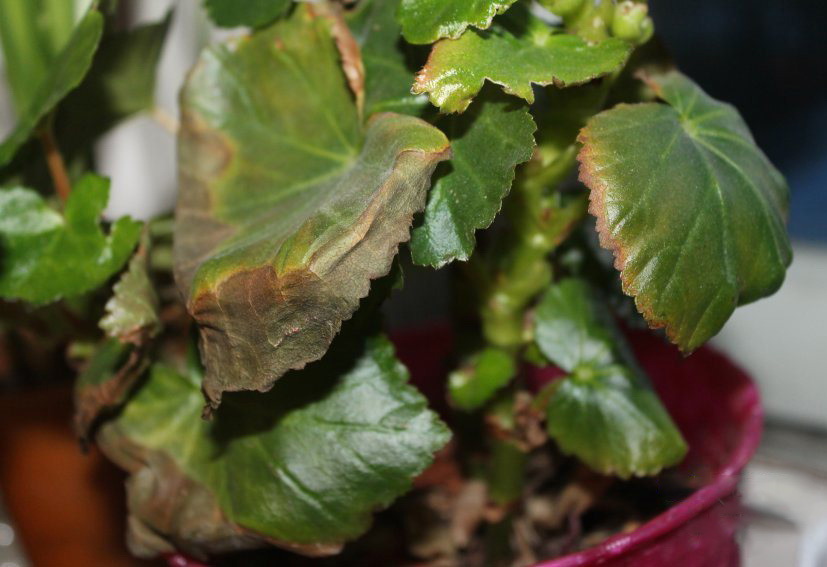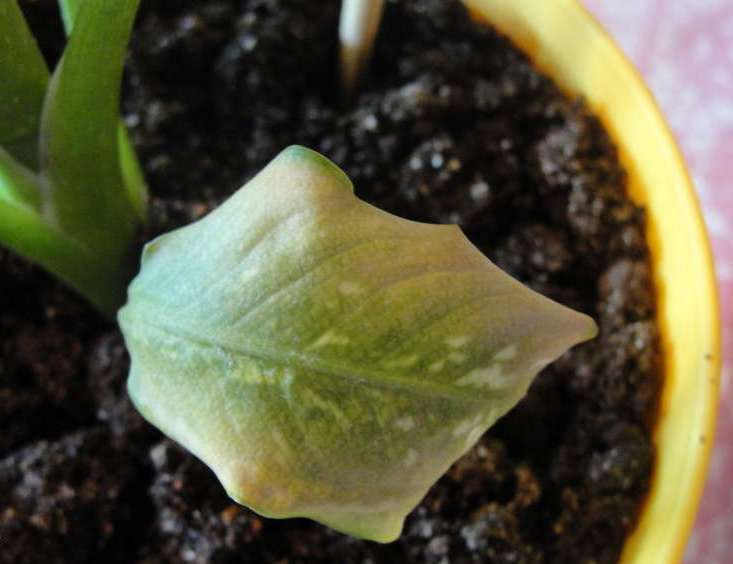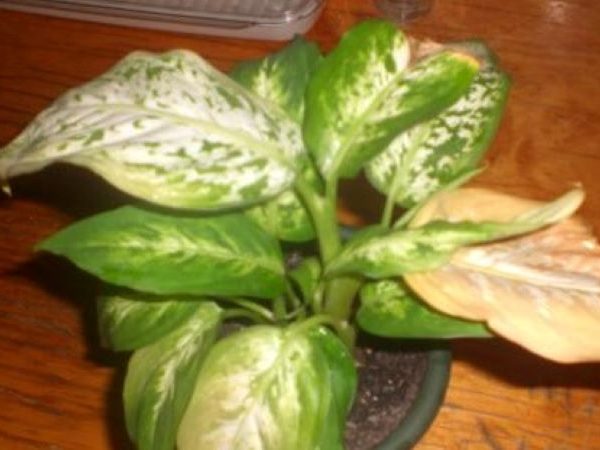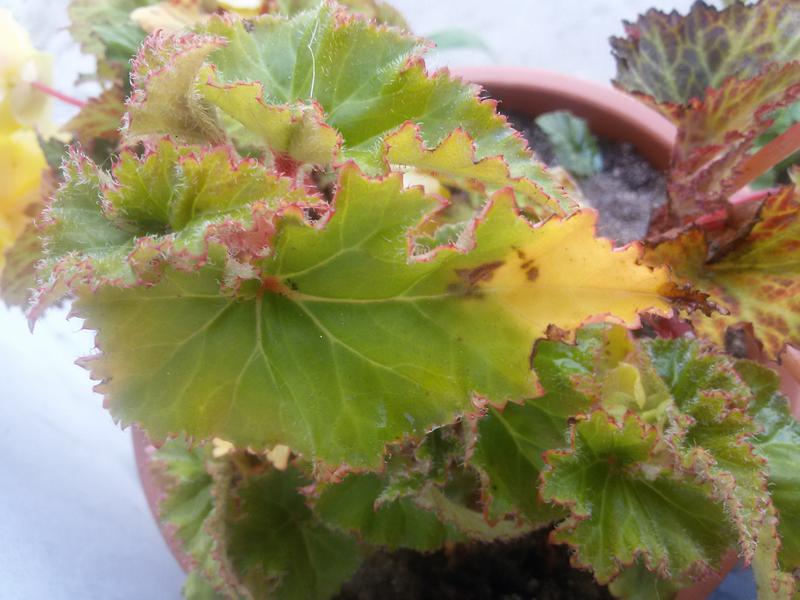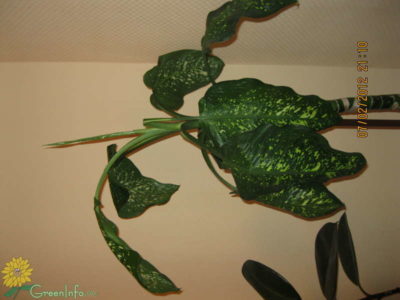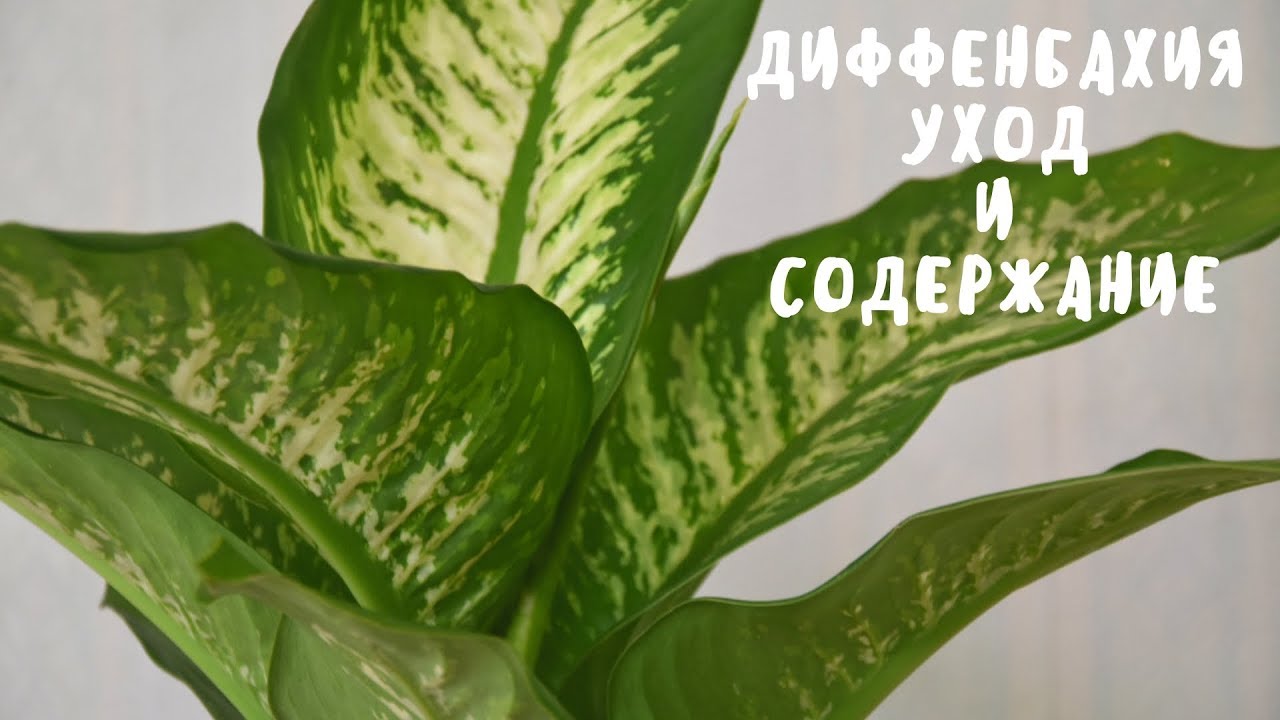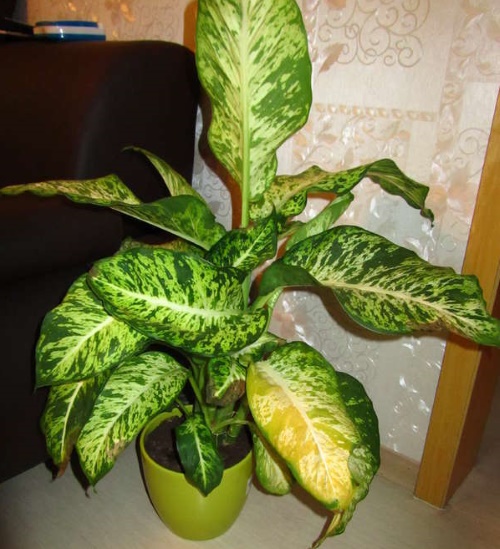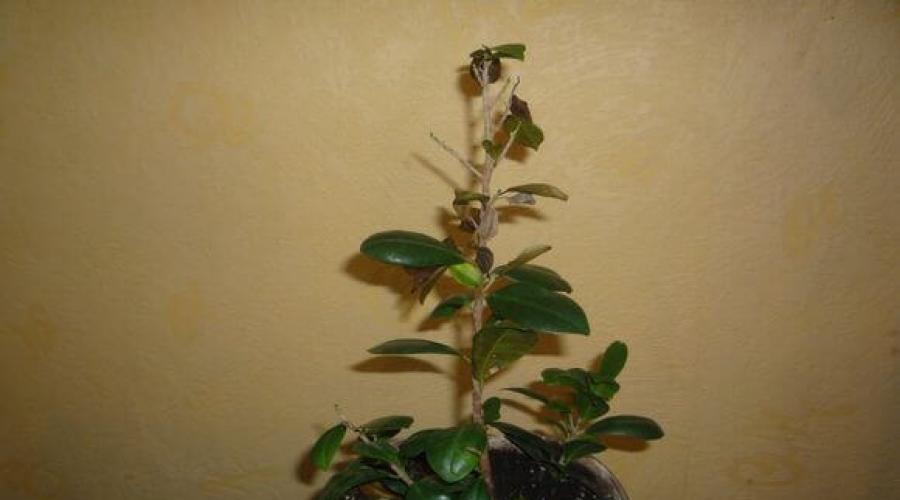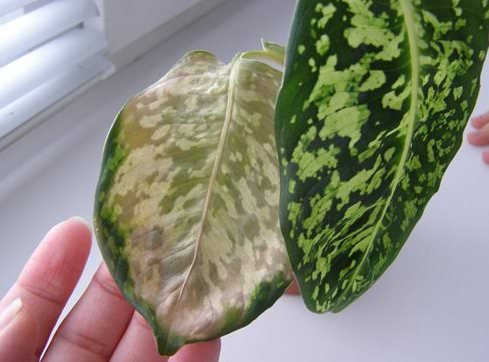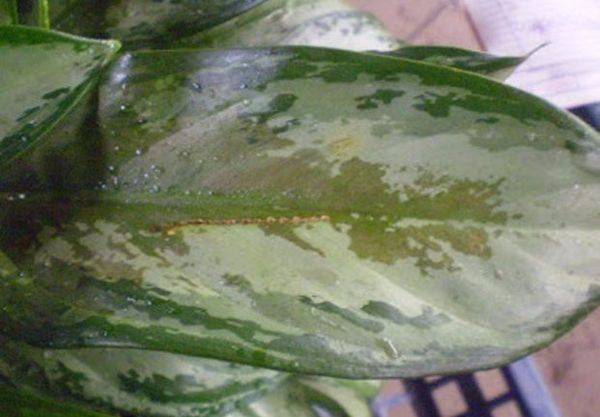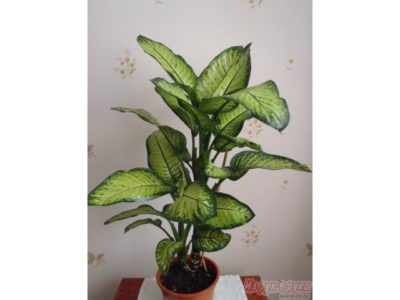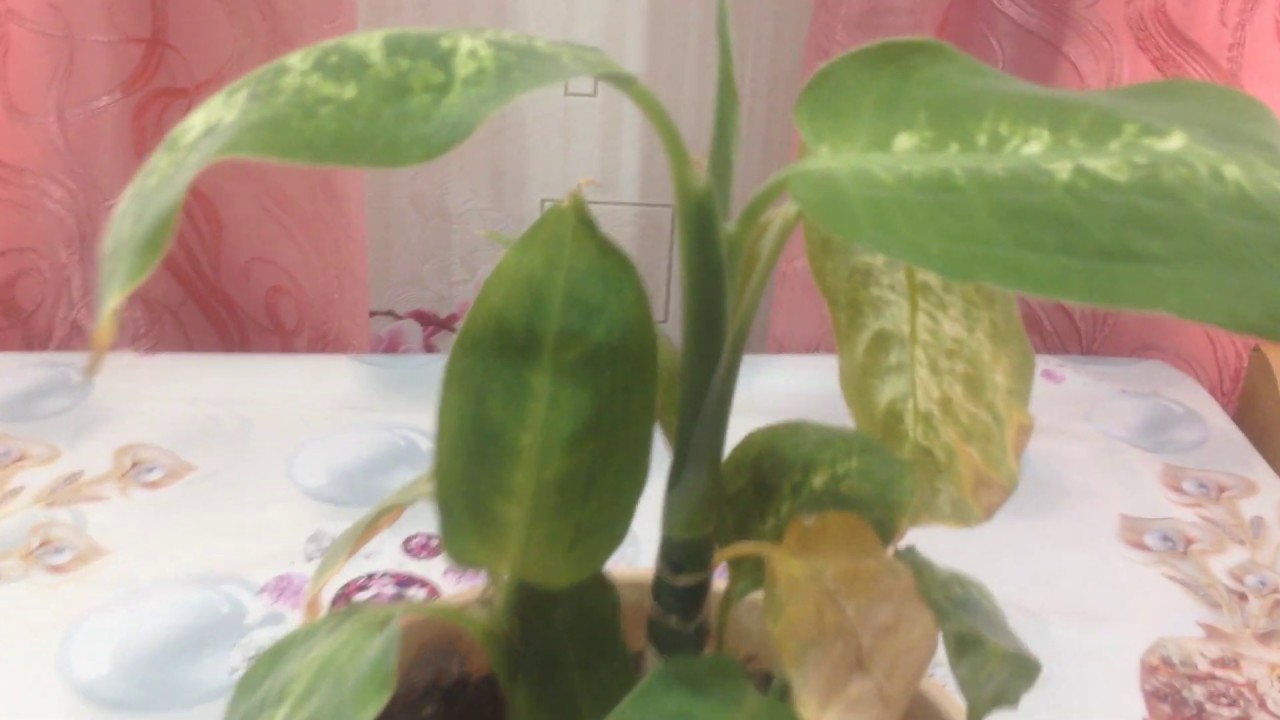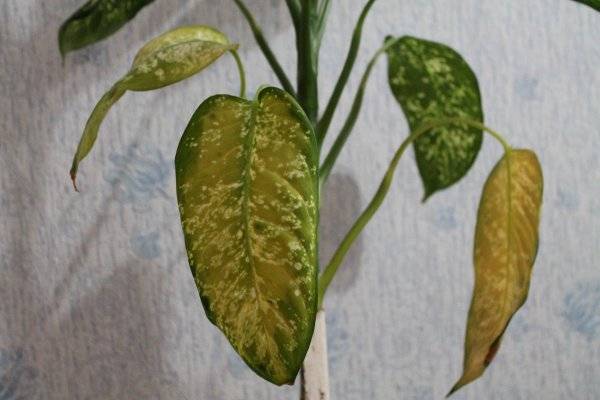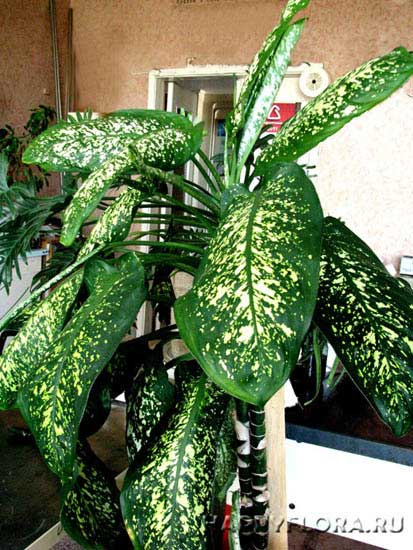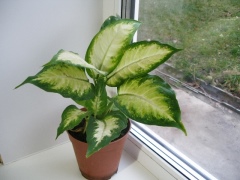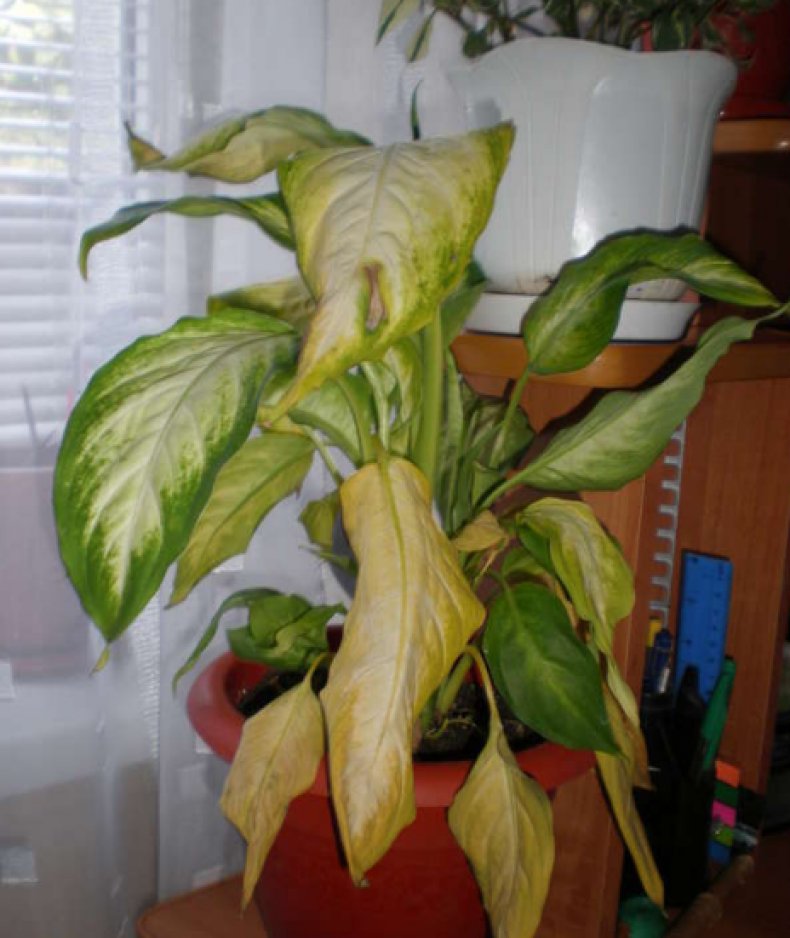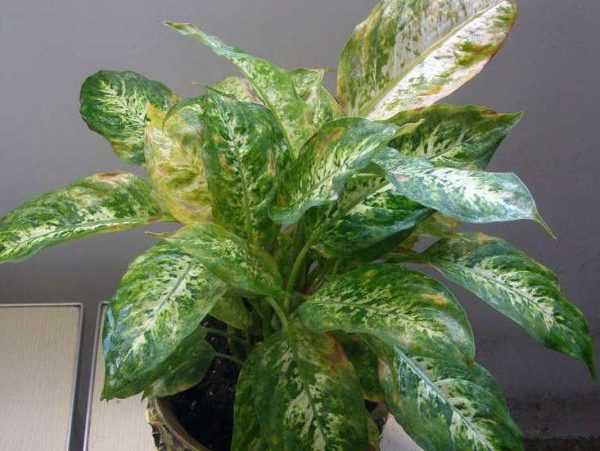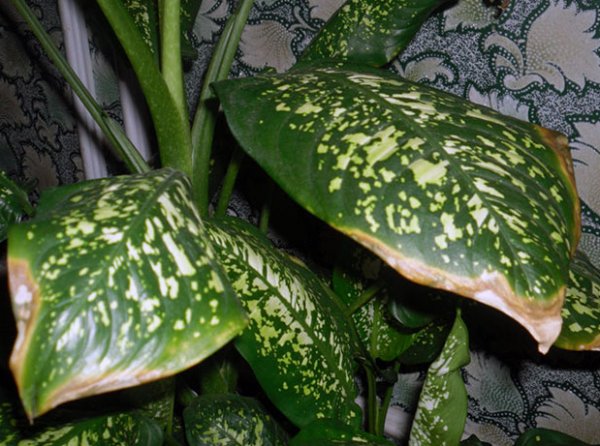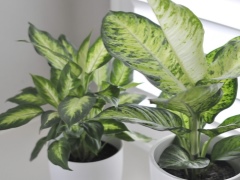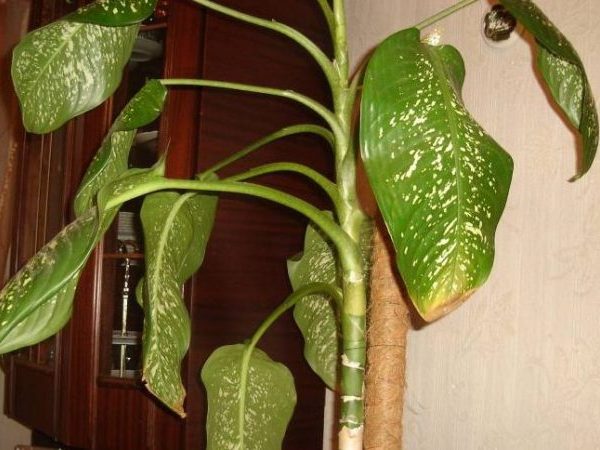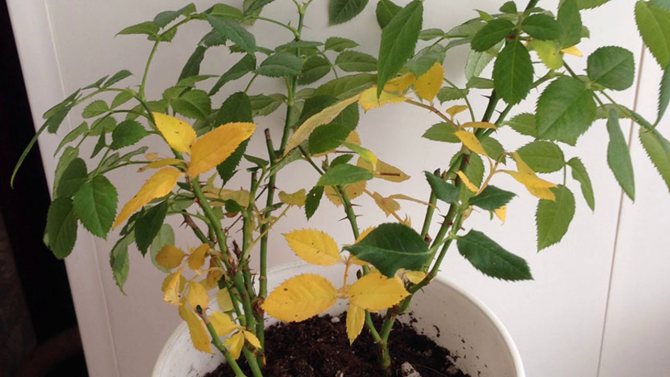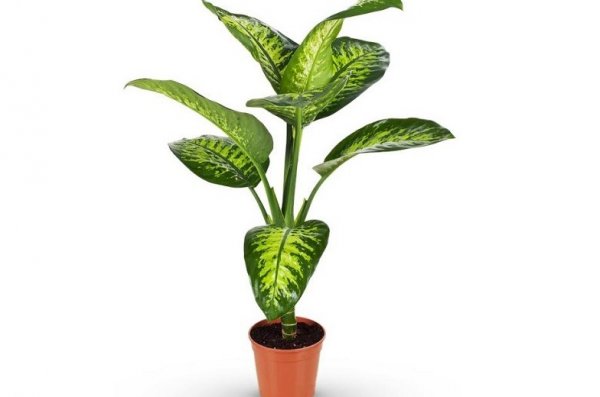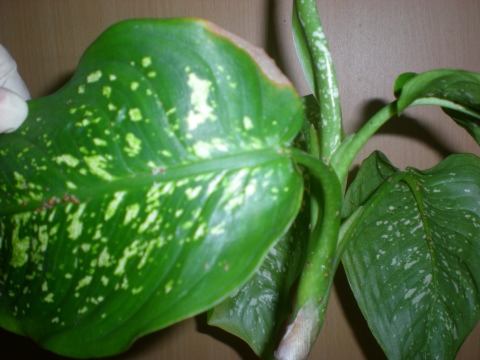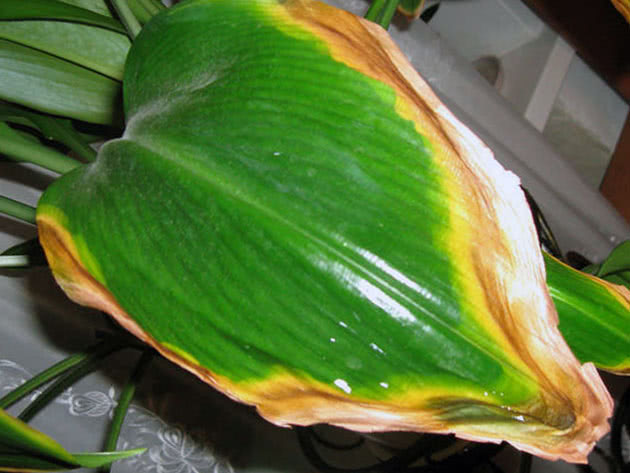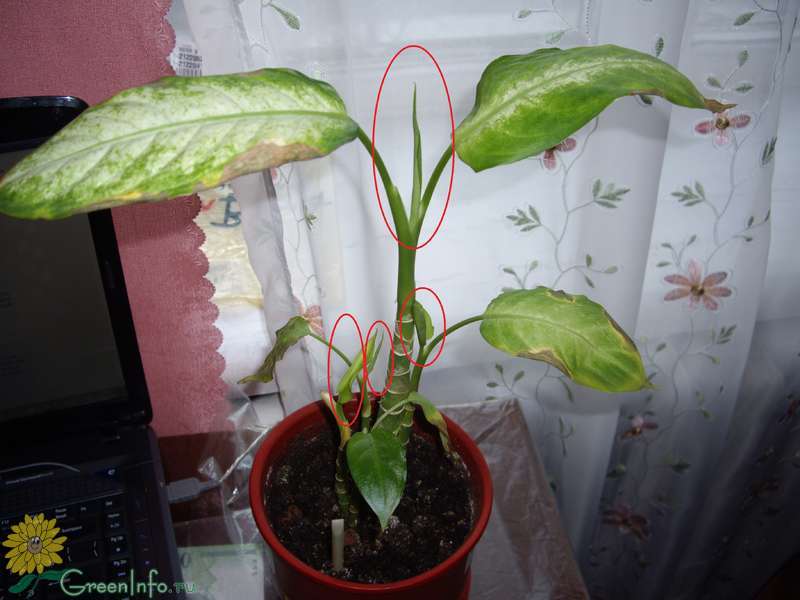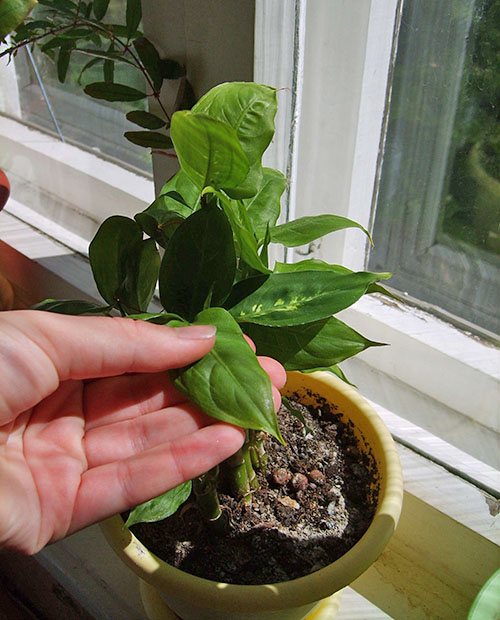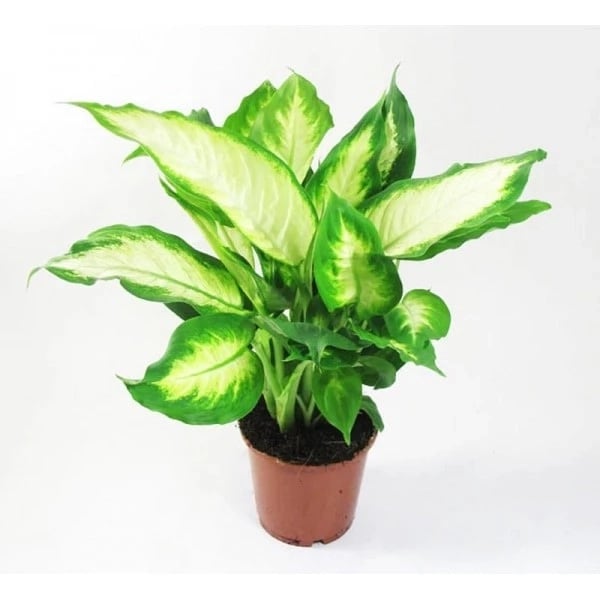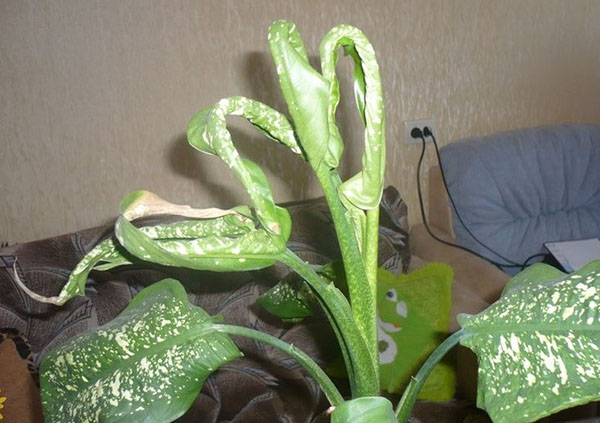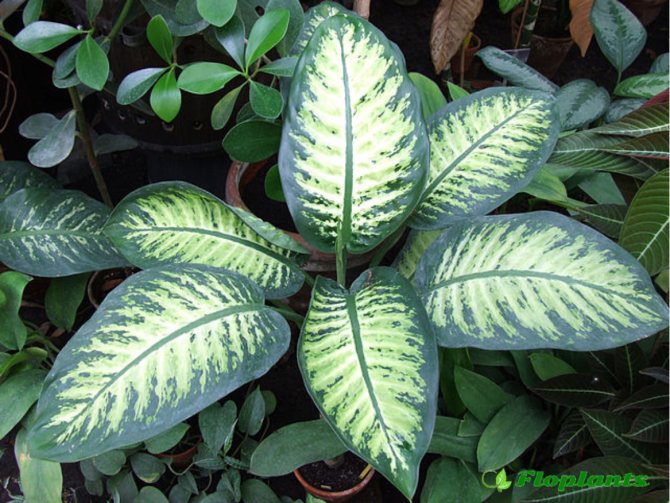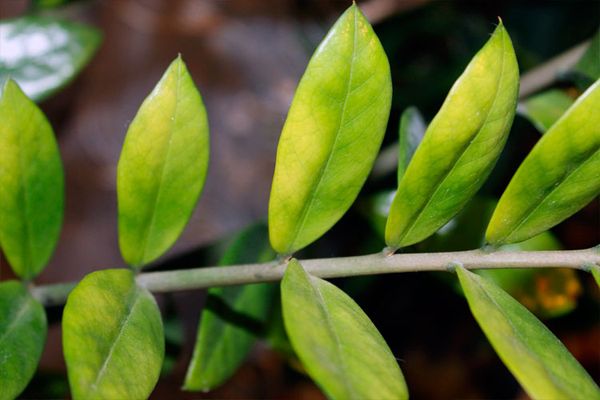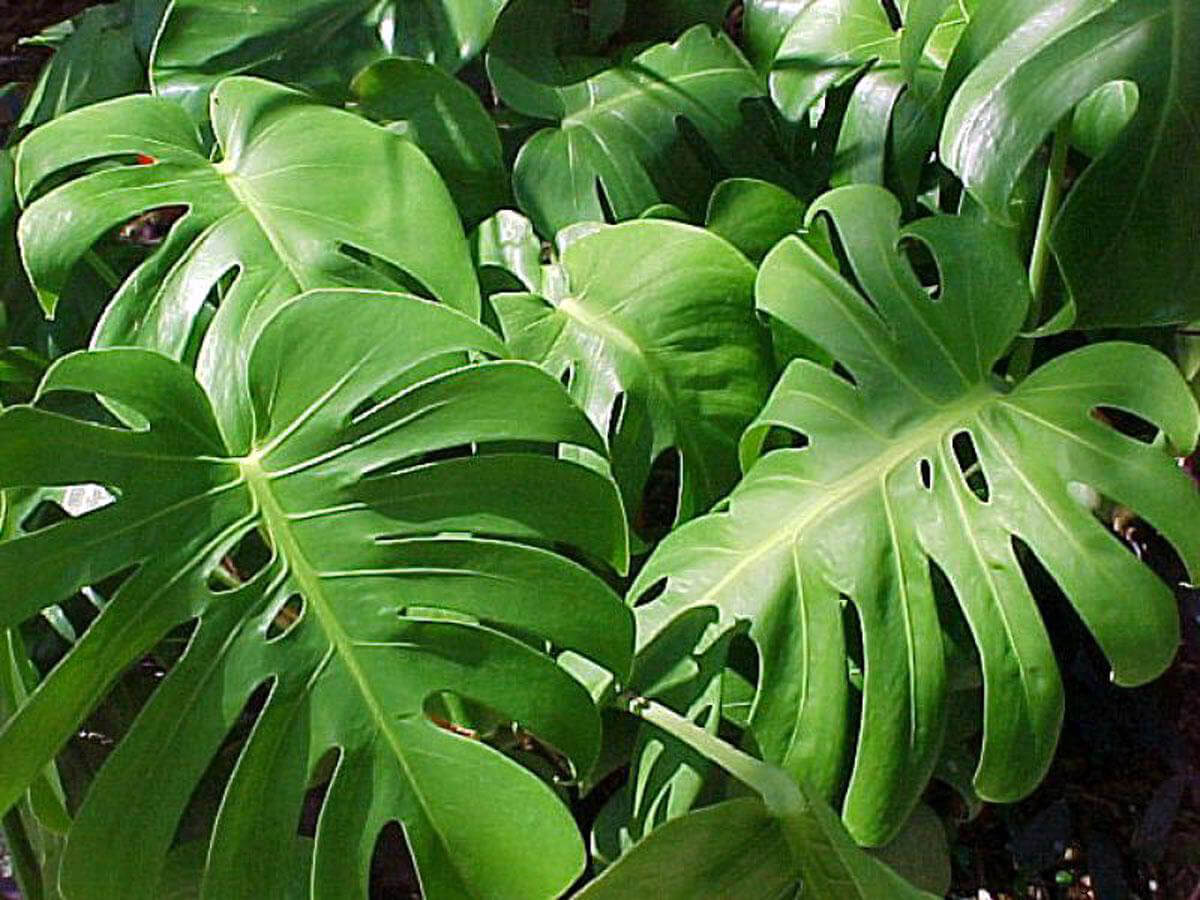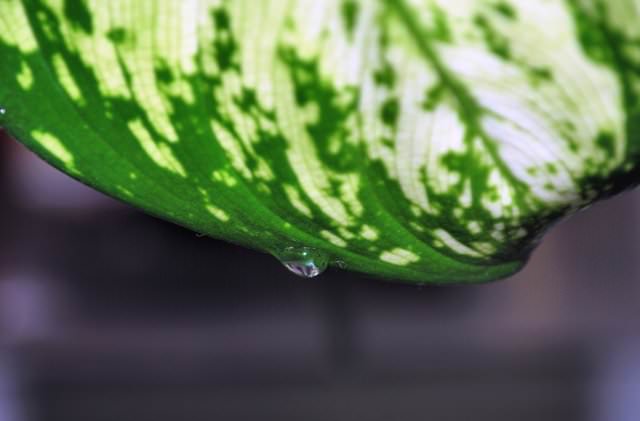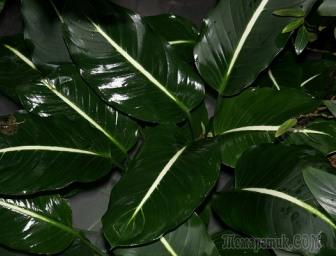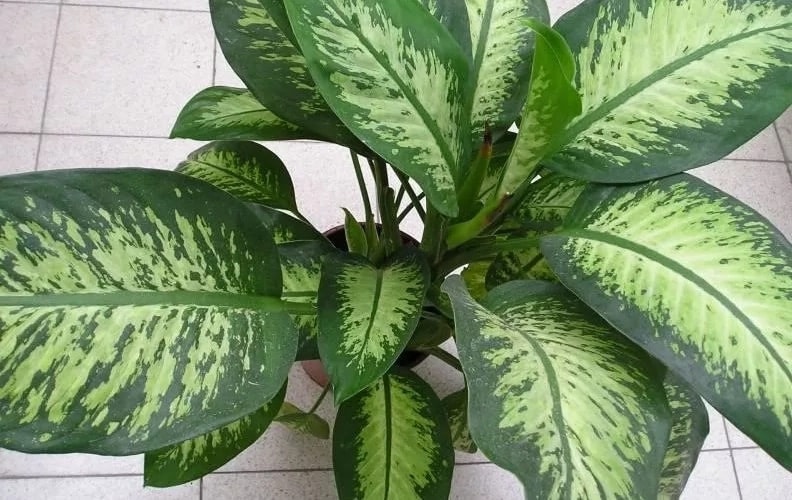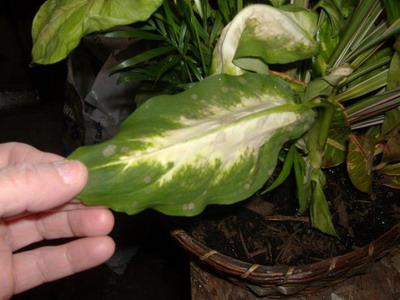Improper care and maintenance of dieffenbachia
Illumination level
For a plant, a long daylight hours (at least 10-12 hours) throughout the year are very important. Lighting should be diffused, culture should be protected from direct sunlight. On short light days in autumn and winter, additional lighting with phytolamps or fluorescent lamps will be required. The most favorable illumination level is from 2500 to 2700 lux.
Bright light and direct rays of the sun, when they hit the plant, leave a burn in the form of dry spots of a brown tint against a background of appearing yellowness. Such leaves can no longer be restored, and it is recommended to remove them. Insufficient lighting will also negatively affect the decorativeness of dieffenbachia. This can happen if the crop is grown on a north-facing windowsill or in the back of a room away from a light source. At first, the leaves will turn light green, then almost white, and soon begin to turn yellow. If the plant is promptly rearranged to another place with good lighting, then the normal green color of the leaves will gradually recover.
Violation of watering rules
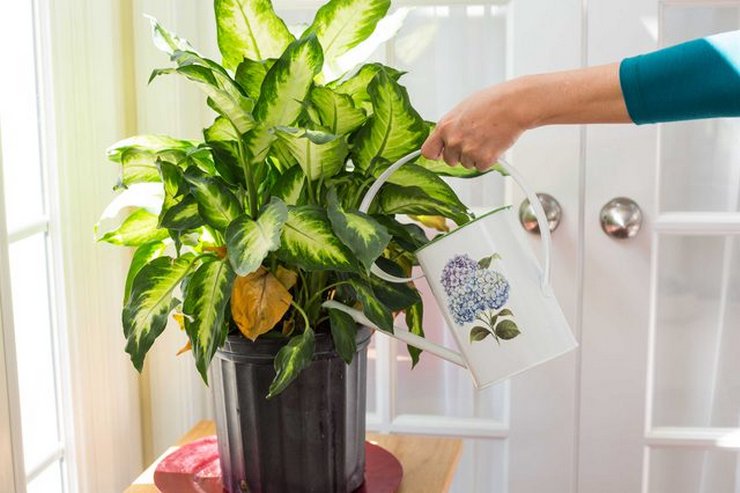
The condition and color of the dieffenbachia leaf mass depends on the volume and frequency of watering. Yellow leaves can be the end of the life of a houseplant due to the regular excess of moisture in the soil. They talk about rotting of the root part, which begins as a result of waterlogging of the soil. The soil should dry out a little before the next watering, the soil should remain light and breathable. And an excess of irrigation water leads to a compaction of the substrate and does not allow the roots to breathe. In addition, excess moisture leads to the appearance and spread of a large amount of fungus in the flower container, algae begin to develop on the surface of the soil.
At the first signs of decay of the root part, it is recommended to urgently remove the flower from the pot, replace it and the flower soil, and carefully examine the roots, rinse, remove diseased parts and treat the cut sites with charcoal. The new flower container must match the size of the dieffenbachia root system. A good drainage layer is necessarily formed at its bottom. The reason for an emergency transplant is a greenish coating on the surface of the ground in a pot with a plant and an unpleasant odor from the moist soil.
The lack of moisture with excessive drying out of the soil mixture is no less dangerous for the culture. If watering is untimely, the leaves of the flower turn brown and dry out slowly.
When watering, it is very important to use only soft water, which has settled for 1-2 days. The leaves turn pale and yellow from hard water
Soil care and fertilization
The soil should be slightly acidic in composition, light, loose, with good water and air permeability and a high content of potassium, phosphorus, nitrogen and humic acids. This soil mix can be purchased at any specialty store. Another (inappropriate for this culture) composition and density of the soil will lead to a lack of nutrition for the root part. This will affect the external characteristics of old and young foliage. Mature leaves at the bottom of the plant will turn yellow, while young ones will grow slowly and develop poorly.
The development of dieffenbachia directly depends on the volume and frequency of dressings, as well as on the amount of such useful elements as nitrogen, potassium and phosphorus.Experienced flower growers advise using complex fertilizers strictly according to the instructions and for the intended purpose, since yellowing of the leaves can begin not only due to a lack of potassium and phosphorus, but also with an excess of nitrogen.
Temperature conditions
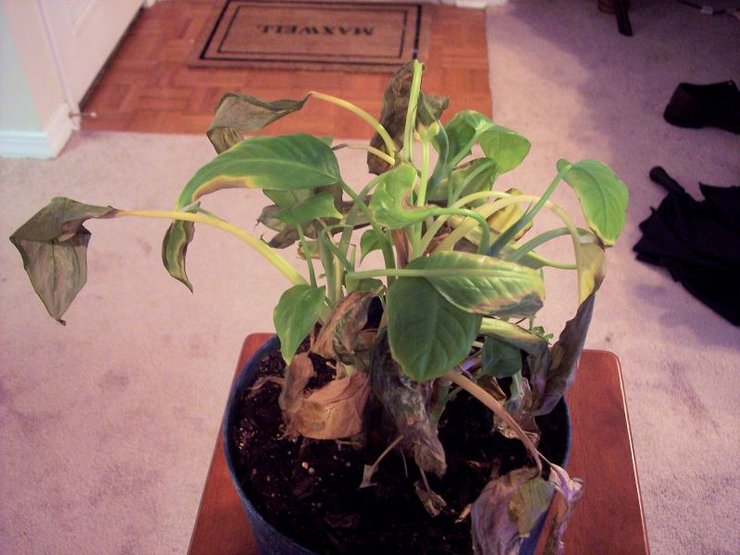
For thermophilic dieffenbachia, sudden temperature changes, regular drafts and cold ventilation are undesirable. This can cause yellow and dry leaves to appear. The optimum room temperature throughout the year is 20-25 degrees. Even a short-term drop in temperature to 10-12 degrees will lead to yellowing and shedding of the lower leaf part. Although the plant will not die after such temperature jumps, its appearance will lose its beauty. The leaves will still fall off even when the temperature returns to normal.
The main reasons for the appearance of yellow leaves
- Too much watering. Excessive watering leads to decay of the roots, because of this, the leaves do not receive enough nutrients and begin to turn yellow and dry.
- Cold room. The plant is thermophilic. If in a room where dieffenbachia is kept, the temperature is kept below 17 degrees, then this will invariably affect the condition of the leaves, they will turn yellow. The room temperature should be 18-25 degrees.
- Insufficient air humidity. The indoor air should not be dry, because then dieffenbachia will not be able to receive the necessary nutrients from the surrounding air space. She feels comfortable only in a humid environment.
- Bright sun rays. Direct exposure of the plant to the rays of the sun will burn the leaves. They can be very badly damaged, so you should not expose dieffenbachia to the sunny side.
- Exposure to a draft. Drafts affect the immunity of the plant, it can get sick and necessarily turn yellow, the leaves will begin to dry.
- Spider mite. A very dangerous pest, which, unfortunately, is difficult to detect, causes diseases in dieffenbachia, including yellowing of the leaves. They turn yellow in your favorite plant only once a week. The problem lies precisely in the appearance of a spider mite.
- Plant growth. If the upper leaves are actively growing, and for some reason they turn yellow from below, it means that the flower does not have enough space in the pot and needs to be transplanted.
Ways to solve the problem
- If the plant has been exposed to the sun for a long time, it will be necessary to cut off the damaged leaves and find the optimal place for the flower to live. We must not forget that Dieffenbachia loves rather bright lighting, but not direct sunlight! Lack of lighting will also negatively affect the state of the foliage, for this it is necessary to periodically turn the flowerpot with different sides to the most illuminated side.
- If the root system is rotting, it is recommended to dig up the plant, cut off any rotten roots and transplant it into a smaller pot. It is necessary to make drainage in it, add coal to the soil. After transplanting dieffenbachia, you will need to water infrequently for some time, and then as the soil dries out.
- If the room is hot and the humidity is insufficient, the plant must be sprayed or a vessel with water placed near the pot, which, when evaporated, will saturate the flower and the space around it with moisture.
- If the room is cold, it is necessary, accordingly, to place the dieffenbachia in a warmer room without exposure to drafts.
- If a flower is affected by a spider mite, all dieffenbachia leaves are treated with a solution of soap and water, then sprayed with some special remedy for this disease. After that, it is recommended to periodically examine the plant for the presence of spider mites.
- And there are also natural reasons for the appearance of yellow leaves in Dieffenbachia. When the plant reaches the age of about two years, its leaves begin to turn yellow and fall off, which is quite natural.Leaves leave the trunk from below, exposing it. In this case, yellowed and dried leaves, especially the bottom row, are best simply removed.
From all this it follows that, since your dieffenbachia leaves turn yellow, it is imperative that you check the conditions of its maintenance, provide full care and, if necessary, cure diseases.
Dieffenbachia - home care
An unpretentious indoor plant in nature grows in a humid tropical climate. Therefore, in order for a bush to grow well in a house or apartment, and its leaves are beautiful, conditions close to natural should be created for the flower. If dieffenbachia leaves turn yellow, it means that some care rules have not been followed. To know what to do in this case, you need to learn - how to care for dieffenbachia correctly?
Since Dieffenbachia was originally a tropical plant, it does not like extreme cold and drafts, and also needs timely watering and pruning.
Excess UV rays can damage the delicate green leaves and turn them yellow, causing them to fall off. Lack of sun can lead to a loss of variegated leaves, and the vegetation itself will become smaller.
The same reaction will occur if the temperature changes greatly: decrease or increase.
Dieffenbachia does not tolerate a lack of water and dry soil, since the plant was originally found in the humid climate of the tropics. Therefore, watering should be regular. It is advisable to do this with standing, melt or rainwater.

Dieffenbachia - why do the leaves turn yellow?
In addition to watering, dieffenbachia requires leaf washing and spraying, which can be done every day.
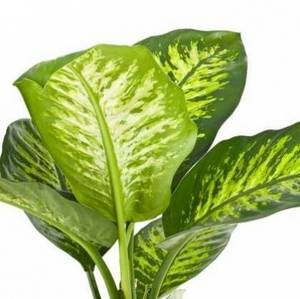
During extreme heat and intensive growth, the plant should be “bathed”. Immerse the plant in room temperature water for 15 minutes. After the procedure, you need to let the water drain well.
Such a revitalization of dry land will only benefit Dieffenbachia. If the air is too dry, wet sand, gravel or moss should be placed in the pan. For evaporation, you can put a container of water next to it.
Painful yellowing
Most often, diseases appear due to improper care. It's simple: the plant weakens, so uninvited guests stick!
Attack of harmful insects
Here are the most common enemies of dieffenbachia.
True, at the initial stage of infection it is difficult to see them. But you can see that the flowerpot began to grow more slowly, new leaves do not appear for a long time, and the old ones are covered with the smallest yellow dots, or turn yellow more noticeably, zones.
- To prevent ticks (and other enemies), often spray the plant and wipe it with a damp cloth.
- If something alarms you, rub the sheet plates with soapy water.
- Did you see a couple of insects? If these are scale insects, you can dip a cotton swab in alcohol or vodka and wipe them in the sink, and spray the flowerpot with soapy water.
- Is everything very bad (the infection is strong, the soap does not help)? We'll have to buy poison. Acaricides help from ticks, insecticides from other insects.
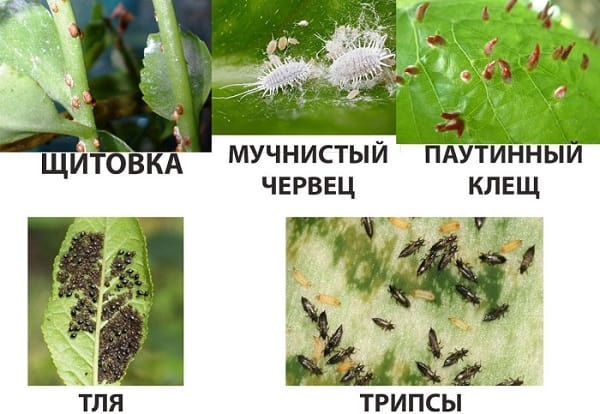
Fungal diseases
- Anthracosis: spots of black-brown color with a yellow border.
- Spotting: Small specks with an orange border that grow strongly over time.
- Fusarium: Dieffenbachia withers and turns yellow all over. In addition, the disease attacks the root, killing the flower.
- Root rot: a dark "stocking" with a gray top appears at the bottom of the trunk.
The first two diseases can be cured by fungicides, preparations with copper in the composition.
With root rot, the bush is dug up, the rotten root is cut to a healthy place, the cut is disinfected (at least with activated carbon). The soil in the pot must be completely changed. After that, seriously reconsider the watering schedule - since the roots have begun to rot, you overflow the plant and / or it freezes over.
Fusarium and root rot (if all the roots rot) are very difficult to cure.If the disease is started, immediately eliminate the plant before the pestilence begins among the rest of the home flowerpots. The pot can be thrown away too, but if the pot is very beautiful and you feel sorry for it, sterilize it with a dark solution of potassium permanganate or boiling.
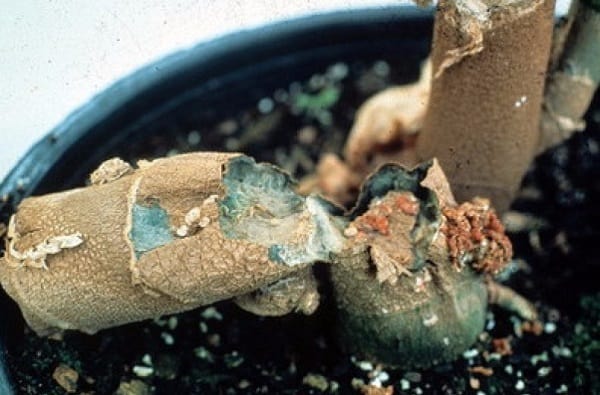
Bacterial diseases
They can be recognized by an unpleasant smell from the soil or from leaves. Wet putrefactive spots appear on dieffenbachia.
Such diseases are also considered a reason to get rid of a sick flowerpot. If you live in a village, do not throw it away on the site and do not throw it into a compost pit - it is better to burn it right away. By the way, in the case of fusarium, do the same.

Viral diseases
Another untreatable case.
Such diseases are carried by insects. This is another reason why pest insects must be dealt with quickly and ruthlessly.
You can recognize such a disease by the strange-looking leaves: circles, strange spots can go along them, the color of the leaf plates can turn bronze.
But how to care for this decorative leafy plant so that it does not hurt and turns beautifully green? A girl who has been successfully growing Dieffenbachia for a long time will tell:
Nursing costs and illness
No matter how you strive to provide your Dieffenbachia with good care, no one is immune from mistakes. Therefore, consider, first of all, these same mistakes, from which the leaves of the plant turn yellow. So why do dieffenbachia leaves turn yellow?
- Insufficient watering. If you water the plant from time to time or just slightly moisten the soil, the leaves on Dieffenbachia will begin to turn yellow. In this case, it is enough to simply water the flower more often and more abundantly.
- Uncomfortable temperature. Dieffenbachia is a heat-loving plant and at low temperatures for it, it can begin to shed leaves, which first begin to turn yellow and dry out at the tips. In this case, you should rearrange it to a warmer place.
- Excess fertilization can also cause yellowing and drying of the leaves on dieffenbachia. If you notice that this happened soon after the next feeding, then transplant the plant into a new soil mixture. Otherwise, you will not be able to rid the soil of excess minerals.
- Transplant errors. There are two possible oversights here. First, you can burn the roots of the plant by keeping it in a solution of potassium permanganate (as recommended by many growers). Secondly, the plant may react this way to an unsuitable soil mixture. In the first case, you need to wait for dieffenbachia to recover on its own, and in the second - to change the soil in the pot.
- Dry air can also cause dieffenbachia leaves to turn yellow and dry out. There is only one way to help: spray the leaves and air around the plant, use a humidifier, or simply put a wide container of water next to the flower.
Spider mites can also cause yellowing of the leaves (in addition to care errors). The most unpleasant thing about this disease is that it is almost impossible to notice the pest on the affected leaves at first. Nevertheless, there is one characteristic feature that makes it possible to identify this very reason: the leaves turn yellow at a constant frequency - once a week.
Having noticed this, try to find the pest after all. You need to look for a tick on green leaves that are located closer to those that have already turned yellow. The tick will look like a lot of little black dots. To rid the plant of the parasite, the leaves must be washed with soapy water or tobacco infusion, and then treated with a suitable insecticide.
Reduced temperature and draft
Dieffenbachia is a thermophilic tropical plant. At low temperatures, Dieffenbachia can shed all the leaves (especially with a sharp drop in temperature).
The leaves turn yellow very quickly throughout the plant and fall off, except for the very top ones.
The reaction of dieffenbachia to a draft is drying and yellowing of the tips of the leaves.If such symptoms occur, you need to remove the plant away from opening windows, otherwise it may turn yellow completely, and then lose all foliage.
Dieffenbachia can also react when kept in an air-conditioned room. Being near the air conditioner under a stream of cold air, it will certainly shed its leaves and lose its beautiful appearance.
You cannot keep this plant not only under air conditioning, but even away from it, because it does not tolerate temperature changes in such a room very well.
Description of the plant
The leaves of this plant are oblong and, depending on the variety, have a different shade of green.
Dieffenbrachia is distinguished by an interesting pattern on the leaves, consisting of:
- Stripes;
- Strokes;
- dots and spots of yellow, green, light green colors.
The trunk of the plant is low, and over time it becomes flatter.
The only drawback of dieffenbachia is its poisonous juice, which can cause swelling of the tongue and larynx, as well as provoke loss of vision when the juice gets on the mucous membrane of the eyes.
Flower sap can harm children and pets more severely.
That is why it is worth observing safety measures and caution for those people who nevertheless decided to have such a flower at home.
Blanching and dark spots
The main advantage of the hovea is its beautiful foliage of a rich, juicy green color. If its shade is far from this, the plant has become pale, then the reason for this may be a draft. It creates sharp fluctuations in temperature and humidity, and the plant does not like this. Draft leads to disruptions in the process of photosynthesis, which immediately affects the color of the leaf plates. In this case, there is only one way out - to rearrange the pot to a place where there is no wind.
The second reason for the too faded color of the plant may be a lack of light. But you should not expose the palm tree in direct sunlight: this way it will get burned and covered with spots, the foliage will shrink sluggish. It is better to choose a place for her, illuminated by diffused light, or put it a little further from the window.
Another problem with a palm tree that hovea owners should pay attention to are small black dots. They appear due to non-compliance with the conditions for caring for a houseplant.
Main reasons:
- too high temperature in the room;
- lack of moisture in the soil;
- overflow and low temperature.
If you properly care for the plant, then the hovea will delight the eye with beautiful green foliage. If she does not like the conditions, then she will immediately signal this to her owners by blackening or yellowing of the foliage, dry tips or small dots. By adjusting the conditions of detention to normal, the palm tree will quickly recover.
Fungal diseases
Dieffenbachia, which belongs to tropical ornamental crops, is often subject to fungal diseases. The main reasons are high humidity and high room temperature, as well as excessive watering. If you notice that dieffenbachia has stopped in growth and development, has begun to wither, turn yellow, bend to the ground or dry, reconsider the growing conditions and the peculiarities of caring for an indoor flower.
Anthracnose
Spores of the fungus Colletotrichum gloeosporioides lead to the development of anthracnose. First, small specks appear on the leaves, which gradually grow and cover the entire surface of the leaf plate. Leaves begin to curl inward or, conversely, unwind outward. The cuttings die off, as a result of which the leaves crumble. Answering the question of what to do if the leaves turn yellow in Dieffenbachia, it is recommended first of all to reconsider the conditions in which the ornamental culture grows. Leaves may curl or unfold incorrectly as a result of inappropriate humidity and high air temperatures.Systemic preparations of fungicidal action will help to effectively cope with anthracnose, in particular, we are talking about "Vitaros" and "Fundazole".
Fusarium
Fusarium is caused by fungi of the genus Fusarium solani and appears as dark, depressed spots on the roots and root collar of Dieffenbachia. As a result of damage to the root system, the leaves begin to turn yellow, turn in the opposite direction and wither. In this case, the damaged areas are covered with a pinkish mycelium of the fungus. In order to prevent fusarium, you can use "Glyocladin" and "Trichodermin", but with an abundance
Leaf spot
Phaeosphaeria eustoma fungi provoke the development of leaf spot in Dieffenbachia. Fungal spores are carried by infected plants and also by water. The main signs of the disease are considered to be a small brown drop with bright orange edges on the leaves of an indoor flower.
The disease develops rapidly, the spots increase in size and cover an ever larger area of the leaf plate. To cope with leaf spot, you need to maintain an optimal temperature regime in the room and an appropriate air humidity. At the first symptoms, it is recommended to treat indoor flowers with "Fundazol" or "Vitaros".
Root rot
Root rot pathogens are Pythium and Phytophthora fungi. It is almost impossible to identify the disease at the initial stage, since the causative agents of fungal infection affect the root and root neck of dieffenbachia. In the lower part of the trunk, brown spots are formed, covered with a pale gray mycelium. As a result of rotting, the trunk gradually breaks and the flower begins to fall off.
The main causes of root rot are: contaminated soil, lack of drainage system, excess moisture in the soil, high air temperature, poor ventilation, lack of lighting, improper fertilization, etc. Many novice growers are interested in how to effectively deal with root rot. In addition to observing the technique of growing dieffenbachia, it is recommended to partially replace the substrate, feed the flower with potassium fertilizers and treat it with a systemic fungicide. In this case, "Profit Gold", "Previkur" or "Ridomil Gold" will do.
Bacteriosis
Sometimes dieffenbachia suffers from bacteriosis, which manifests itself in the form of watery spots with clear boundaries of a gray or brown hue. In this case, not only the aboveground, but also the underground part of the plant trunk suffers. Over time, gray-brown watery spots begin to appear on the leaves.
Unfortunately, bacteriosis refers to bacterial ailments, which are almost impossible to cope with. In case of damage to a houseplant by pathogens of this disease, it is necessary to treat the flower with copper sulfate or Bordeaux liquid, after removing the damaged leaves and branches. Observe the farming regime and always work with clean tools.
Causes of yellowing of dieffenbachia leaves
Why dieffenbachia leaves turn yellow - this question interests many amateur gardeners. Such symptoms in this plant can be caused by many reasons. Sometimes this is due to the natural processes characteristic of dieffenbachia, but more often - with mistakes in caring for it.
Direct rays of the sun. Almost all indoor plants, including dieffenbachia, are afraid of direct sunlight, which can cause leaf burns. Regardless of how thermophilic the plant is, under the active influence of ultraviolet radiation, its leaves turn yellow and eventually die.
Excessive watering. If there is too much moisture, the dieffenbachia root system begins to rot. Dieffenbachia leaves at the same time cease to receive enough nutrients, become stained, begin to dry, turn yellow and fall off.
Low air humidity. Dieffenbachia loves a moist environment.If the air in the room is too dry, the plant will not receive the substances it needs from the air, which will lead to wilting and yellowing of its leaves.
Low temperature. This plant thrives only in warmth. If the room is very cold, especially during winter, the leaves will turn yellow and curl. Therefore, it is recommended to put it in that room and in such a place where the air temperature is always high enough.
Drafts. They are very dangerous for dieffenbachia, since they sharply reduce the resistance of this flower to disease. If dieffenbachia stands in a draft, its leaves will surely begin to turn yellow. Hard water used for irrigation. If water is taken from the tap for irrigation, it must be defended so that impurities harmful to the flower settle to the bottom.
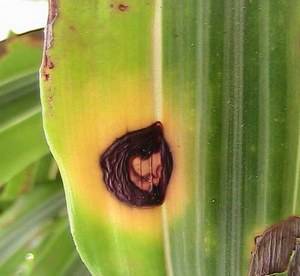 Lack of minerals. If the soil in which Dieffenbachia is located is poor in nutrients, the leaves of this plant may begin to turn yellow. Conversely, an excess of mineral components in the soil can lead to the same sad result.
Lack of minerals. If the soil in which Dieffenbachia is located is poor in nutrients, the leaves of this plant may begin to turn yellow. Conversely, an excess of mineral components in the soil can lead to the same sad result.
If the leaves turn yellow soon after transplanting the plant into fresh soil, it will be necessary to re-transplant, with more careful control of the soil composition.
Spider mite. This pest also causes yellowing of dieffenbachia leaves. The most annoying thing is that it is difficult to detect. It is possible to determine whether it caused yellowed leaves by the frequency of yellowing of the leaves. If the problem is in the spider mite, the leaves will turn yellow strictly once a week.
Natural growth. If the top is actively growing, and the lower leaves of Dieffenbachia begin to turn yellow at the same time, it means that the flower simply does not have enough space to continue normal growth. You just need to transplant dieffenbachia into a larger pot.
Yellowing at the tips
More often the tips turn yellow and dry out due to lack of light in winter and dry air. October to the last month of winter is a dangerous time for yucca due to the reduced daylight hours. If the weather is cloudy outside, the plant will not like it either. Therefore, in the cold season, the appearance of the yucca may deteriorate somewhat.

Treatment for yellowing consists in the use of phytolapma (or any other local lighting). If you organize a palm tree 10-12 hours of diffused light a day, it will stop the yellowing process and heal the plant.
If the matter is in dry ends, then it makes sense to check if the batteries heat up too hot during the heating season, and if the yucca is too close to them. The emphasis should be on air humidification. There are special devices for this. Even simple vases of water (for flowers) can help in this situation. Today on sale you can find decorative ceramic vases-humidifiers, they are fixed on the wall, water is regularly collected in them. For a small room, this is quite a way out.
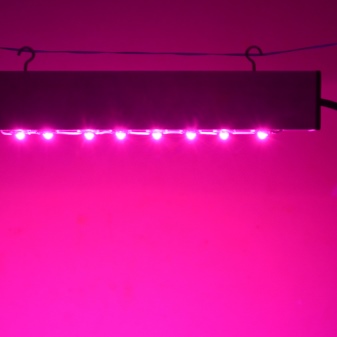
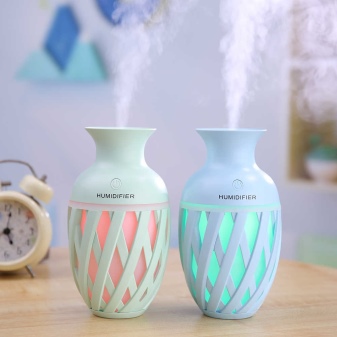
Methods to combat yellowing of dieffenbachia leaves
What should you do if the leaves of your favorite Dieffenbachia began to turn yellow? Recommendations will directly depend on the reasons that influenced these problems.
If the problem is in the sun's rays hitting Dieffenbachia, it will be enough to carefully cut off the burned leaves and put the pot in a shaded place, or to protect the plant from the sun. Don't confuse the sun's rays with good lighting! Dieffenbachia loves a lot of light and the lack of it can also lead to problems with the leaves. Therefore, it is recommended to periodically turn the flower pot with those sides to the window that receive little light.
When the roots decay, you will need to get the flower out of the pot and remove the rotten roots, and then plant the plant in a smaller pot. In a new pot, you must first lay a small layer of drainage, and then pour soil on top with the addition of charcoal.The first time after transplanting, you will need to reduce watering, and in the future, water the plant only when the soil is dry enough. This tactic will avoid root rotting in the future.
With insufficient air humidity, you can periodically spray the room with a spray bottle, or put a large container of water next to the dieffenbachia, which will evaporate and saturate the air with the moisture necessary for the plant.
The ideal option for diphenbachia is to install a humidifier in the apartment, which will have a beneficial effect not only on plants, but also on the health of residents.
If there is a lack of heat, you need to rearrange the dieffenbachia in a warmer place, protected from drafts, or provide heating of the room.
For the normal life of this plant, it is required to select the correct composition of the soil. The best option would be a mixture of equal parts of sand and humus, as well as a double part of peat. When feeding Dieffenbachia, you must strictly follow the instructions of the fertilizer manufacturers.
If the spider mite is the cause of the yellowing of the leaves, it is recommended to treat the leaves with soapy water or tobacco infusion, and then spray with some kind of insecticide. Even if the plant looks absolutely healthy, it is necessary to make it a rule to regularly, at least once a week, carefully examine its leaves for the presence of pests.
If you see a lot of black dots on the leaves or on the trunk, you need to immediately treat the plant with suitable preparations. The earlier the pest was detected, the higher the likelihood of maintaining the health and presentable appearance of the flower.
Dieffenbachia leaves can also turn yellow for quite natural reasons, which do not depend on care. Usually its leaves turn yellow and fall off already in the second year of life. This is a normal biological process. The dieffenbachia trunk becomes bare over time, while the leaves located below turn yellow and fall off. Here is another answer to the question: why do the lower leaves of Dieffenbachia turn yellow?
To restore a pleasant decorative look to the plant, you can simply cut the trunk of an overly stretched plant about 10-20 cm above the ground. New shoots will appear soon. You can make a second flower from the cut part by placing it in a container of water.
Yellowed leaves remaining on the shortened part of dieffenbachia cannot be removed at all, since this is fraught with weakening of the flower. You just need to carefully trim the dried edges. Of course, if the leaf is completely yellow and wilted, then it can be removed completely.
And for those who like to know more, we suggest that you familiarize yourself with the video, which discusses the basic rules for caring for dieffenbachia for its successful content.
Other problems with growing Dieffenbachia
In addition to the pests and diseases listed above, dieffenbachia can suffer from improper care and inappropriate conditions of detention. Consider some questions that often arise from amateur flower growers.
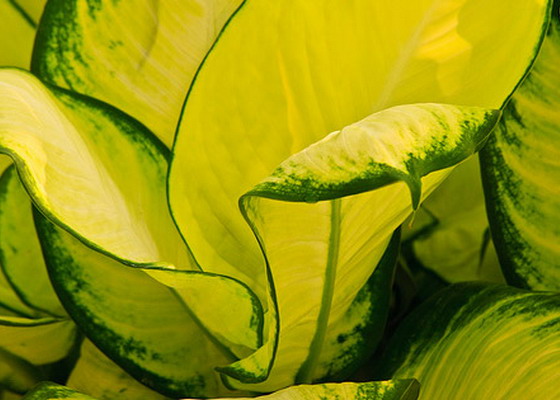
Why does Dieffenbachia turn yellow? The most common causes of this behavior are low air temperatures in winter or drafts, as well as lack of nutrients and watering with hard water. Yellowing of the lower leaves with intensive growth of the top usually signals that the flower needs to be transplanted into a larger pot. Dieffenbachia leaves also turn yellow when affected by root rot.

Why do dieffenbachia leaves curl? This usually happens when infested by pests, also when watering with cold water, drafts and low temperatures.

Why does the stem become soft and rot? The reason is waterlogging combined with low air temperatures. If rotting is small, you can try to remove it by covering the cut with activated or charcoal, if large - cut the flower, root the top.

Why does dieffenbachia dry? If old leaves dry, then this is a natural process, with a loss of decorativeness and exposure of the stem, dieffenbachia is rejuvenated by cutting and rooting the top. If young leaves dry, the reason may be dry soil, cold air, drafts.
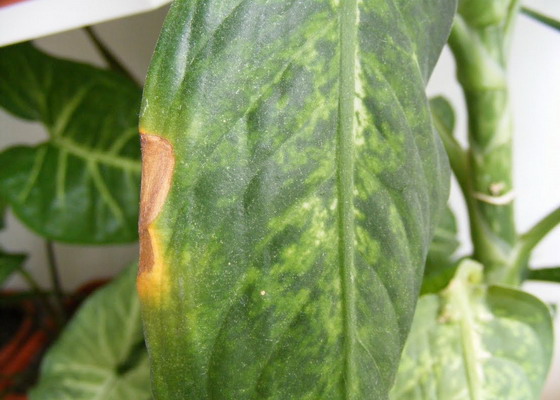
Why do leaf edges turn brown? This is most likely caused by dry soil or low temperatures in winter.
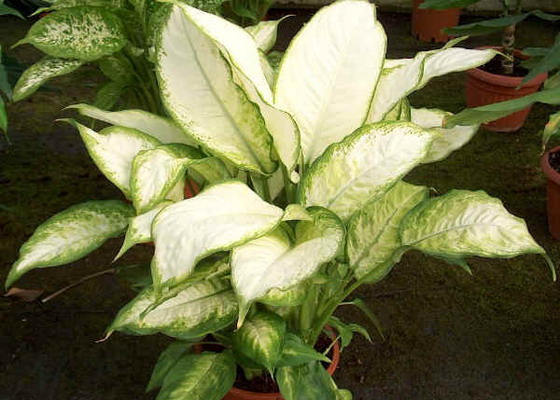
Why are the leaves discolored? The reason is too bright lighting or direct sunlight on the plant.

Why is Dieffenbachia crying? This comes from excessive watering, the flower protects itself from excess moisture in the soil. The same behavior is characteristic of dieffenbachia before the rain. As a rainforest dweller, the plant prepares in advance for excess water and opens channels to get rid of it.

